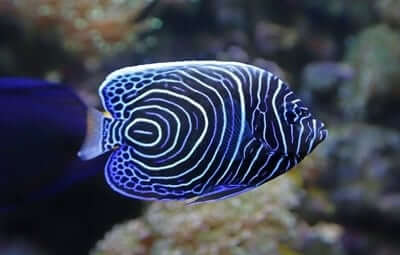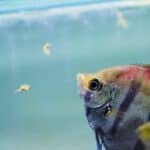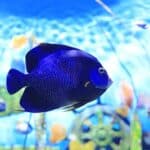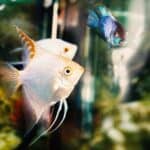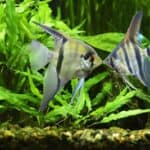Angelfish are hardy fish that can survive just outside of their ideal water parameters. In the wild, their aggressive nature and quick swimming speeds keep them ahead of predators. Thanks to these characteristics, angelfish can enjoy long lifespans.
Angelfish that are kept in a home aquarium will live for an average of 7-12 years. The longest lifespans are found in large angelfish, with emperor breeds living for 20 years. If the angelfish is small, like the dwarf breed, they will live for about 7 years. Saltwater angelfish tend to live longer than freshwater types, but are more difficult to care for.
To increase the lifespan of angelfish, you need to provide them with the right environment. This includes balancing their water temperature and pH levels. You should also ensure that their tank size can accommodate their maximum growth. Most of all, try to feed them as much live food as you can, such as brine shrimp and mosquito larvae. Angelfish that are given live food have been proven to live longer than those offered flakes alone.
Angelfish Lifespan And Size
Angelfish, as a whole, can live for between 7-20 years. That’s a wide margin, but this lifespan largely depends on the breed of your angelfish.
Across oceans and freshwater basins, there are almost 100 different species of angelfish. Depending on their size and the environment they inhabit, they may live for a few years or full decades.
Saltwater angelfish tend to live longer than freshwater angelfish, and also reach larger sizes.
- Marine Angelfish: Fully grown, they can reach up to 12 inches.
- Freshwater Angelfish: When fully grown, they’re far smaller at 4-6 inches on average, but up to 10 inches.
Most angelfish reach their maximum size within 6-12 months. Once they display sexual maturity, they’re fully grown and can now devote energy to reaching their longest lifespan.
| Type | Size | Lifespan |
| Emperor | 12 inches in captivity. 15 inches in the wild. | 15+ years in captivity |
| Peppermint. | 3 inches. | 10 – 15 years |
| Platinum | 6 inches max. | Up to 10 years. |
| Flame | Up to 6 inches in length | 5 – 7 years. |
| Altum | 4 – 6 inches in a tank | 10 -15 years in captivity. |
| Koran | 15 inches maximum. | Up to 20 years in captivity. |
| Dwarf | Up to 4 inches. | 5 – 7 years or more. |
| Swallowtail | Up to 7 inches. | 10 -15 years. |
What’s The Average Lifespan Of An Angelfish?
In the oceans of the world, saltwater angelfish can live for up to 20 years. However, not all angelfish will reach that maximum lifespan, or that eye-catching size. That’s because there are 4 factors that impact an angelfish’s growth and longevity:
- Breed: Flame angelfish have much shorter lives than emperor angelfish.
- Exposure to low water quality: In your home, an angelfish may be short-lived or small when it’s in a bad tank environment. In the oceans, pollution impacts lifespans.
- Exposure to predators: Early deaths are mostly caused by predators, especially when angelfish are small and growing.
- Diet: A well-fed angelfish with a balanced diet will always grow larger and longer-lived. However, that’s not always easy to find in the wild.
While these factors impact freshwater angelfish, they’re even more obvious in saltwater varieties kept in the home. This group of cichlids is rather hardy, but they still need an environment designed to sustain them.
If your tank water’s chemical balance and salinity are wrong, it won’t take long for their health to be affected. Likewise, a mistake early on may shave a few years off your angelfish’s eventual lifespan.
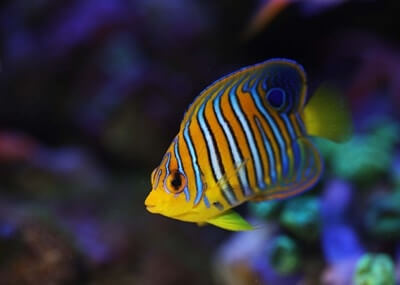
Freshwater Angelfish Lifespan
Freshwater angelfish kept as pets will see an average lifespan of about 7-12 years. That’s because, in freshwater environments, angelfish tend to live shorter lives. This is due to their environment, not just their breed.
Freshwater angelfish are also smaller in size. That’s because rivers, lakes, and streams offer fish much less space than the wide, open oceans.
In fact, there are fewer genetic differences between angelfish species than you’d imagine. According to Marine Biology, even color morphs with dramatically different appearances have no strong genetic differences. This drives home the fact that your angelfish’s environment will be the main factor in determining its:
- Size
- Color
- Energy levels
- Lifespan
How can you make sure your angelfish reaches its maximum age? Let’s explore all the factors you can control in your tank. These will ensure your angelfish grow to a ripe old age.
Water Requirements
Angelfish can tolerate water that’s outside of their ideal requirements, but it can’t be drastically different. They still need a temperature and pH balance that suits their unique chemistry.
Likewise, although they’re happy to share a tank with other fish, they require space to avoid fights. Depending on the species you choose, here are the ideal tank requirements:
| Type | Tank Requirements |
| Emperor | 120-gallon tank. 71 to 82 degrees F8.1 to 8.4 pH |
| Peppermint | 130-gallon tank, because their natural environment is deeper seawater 70 to 75 degrees F6.8 to 7.8 pH |
| Platinum | 30-gallon tank or bigger. 78 to 83 degrees F6.8 to 7.8 pH |
| Flame | 50+ gallon tank75 to 80 degrees F8.1 to 8.4 pH |
| Altum | 50+ gallon tank.75 to 82 degrees F 4.5 to 7 pH |
| Koran | 240 gallons, at the minimum 71 – 80 degrees F 8.1 to 8.4 pH |
| Dwarf | 30-gallon tank required, 77 to 80 degrees F 8.1. to 8.4 pH |
| Swallowtail | 125-gallon tank or more 71 to 79 degrees F 8.1 to 8.4 pH |
Dietary Requirements
Flakes and pellets will be a large part of the angelfish diet for most owners. Depending on the brand, they may be packed with extra vitamins, minerals, proteins, and other nutrients. These ensure your angelfish get a balanced diet without needing a full river or ocean to pick from. However, flakes will never be enough.
Angelfish also require frozen, freeze-dried, and live food to eat. To add variety, and allow your angelfish to hunt a little, you can toss in:
- Brine shrimp
- Mosquito eggs (or larvae)
- Bloodworms
- Mysis shrimp
The enrichment, protein, and other nutrients will help create a more balanced, natural diet for your angelfish. This helps them reach their full size, and live longer.
With that said, if you want your angelfish to reach a very long life, then live food is the ideal approach. Fish that solely eat live food exhibit faster growth, becoming far larger. They also reach a greater lifespan, especially if it’s introduced early on.
According to SpringerPlus, feeding young angelfish formulated foods alone leads to their survival rate decreasing by almost 60 percent. The study also explains that feeding artificial food alone ensures that young angelfish have a 2.5 times higher chance of dying than those enjoying live food.
Environmental Requirements
Angelfish require hiding spaces in order to feel safe. With plants or decorations, they will establish territories, hide from more aggressive fish, and break the line of sight with fish they might otherwise bully. That makes it important to stock your tank with plants like:
- Ferns
- Moss
- Sword plants
These natural decorations also provide your angelfish with something to passively munch on. This can help round out their diet and keep them busy, so they don’t annoy other fish. Most of all, you ensure that:
- The angelfish avoid stressful conflict that may shorten their lifespan
- The angelfish have a feeling of security, which can let them put more energy into growth
Tank Mates
To improve that sense of safety, angelfish might also prefer to live with angelfish of their own breed. According to Behavioural Processes, in the wild, juvenile angelfish tend to shoal with other fish of a similar color palate. This supposedly helps them blend into the group and avoid being singled out by predators. If they were starkly different in appearance, it would be easy to get picked out.
For the average tank, you don’t need to worry about incoming predators. Instead, be sure to avoid placing angelfish with other aggressive breeds. Likewise, avoid keeping fish that are small enough to fit into your angelfish’s mouth. This will keep all your tank occupants on even footing, so there are fewer conflicts.
pH Concentration
The pH concentration of your tank will play a vital role in your angelfish having a healthy lifespan. Once they’re grown, angelfish can be hardy and tolerate conditions outside their ideal range. Adult angelfish are designed with many impressive traits that help them adapt to bad environments. According to Poland’s University of Technology, specifically the Department of Anatomy, angelfish can sustain a long life by:
- Depressing their metabolism
- Increasing their concentration of hemoglobin
- Changing their respiratory adaptability
- Even raising their breathing capabilities
However, young angelfish cannot develop these adaptations in time. This leads to compromised health and early death, usually in a matter of days. That makes it important to keep pH levels exactly at the measures needed for their unique species.
Even as adults, you should avoid putting your angelfish under too much stress. Even if it can survive in the wrong pH balance, it may live a shorter life. With a pH rating of 3.5, even adults can only survive for between 4- 6 days.
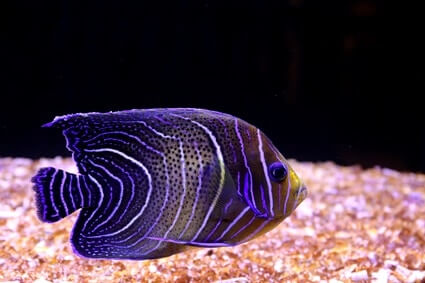
Signs of Low Life Expectancy in Angelfish
It’s not always easy to tell when you’re shortening your angelfish’s lifespan. This could be done accidentally, with the chemical balance only being slightly off. Likewise, you may be feeding your angelfish the wrong kind of food without realizing it.
To help your angelfish enjoy long lives, you can watch out for these warning signs. If the symptoms appear, you can make corrections before they shave weeks or years off your pet’s lifespan.
Clamped Fins
When the aquarium becomes toxic, the fish may exhibit restless behavior. One disturbing trend is called clamped fish, when an angelfish hugs its fins tightly to its body. This is a sign of:
- Infection
- Lack of proper nutrition
- Highly acid water content
Unpleasant Sores
Even without a scope, you may notice wounds or white sores on the body of your angelfish. These are also signs of toxicity. At this stage, the fish may be close to dying or in dire need of a new habitat.
Lack of Appetite
Angelfish must be fed 2-3 times a day. If your fish have other meal options around the tank, such as with live plants, they may not attend every meal. However, if you notice your angelfish skips more than one meal, pay attention.
A lack of appetite may be paired with the angelfish spending more time at the bottom of the tank. It may also be listless and floating irregularly. This can indicate a swim bladder issue or even constipation. A change of water or diet may be necessary, along with medication.
Gasping for Air
When aeration is a problem, carbon dioxide levels and pH will become too high. In this case, angelfish rise to the top of the tank and gasp for air at the surface. This means you need to:
- Change the water
- Add an air stone
- Invest in a filter that agitates the water to add oxygen
Pet angelfish live for about 10 years on average. You need to provide them with the right tank, food, and water adjustments, as necessary.

